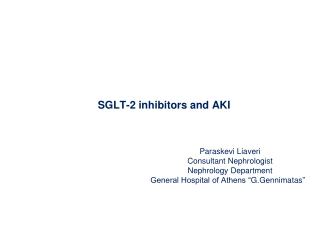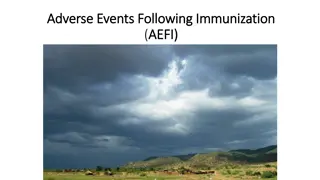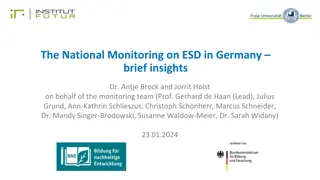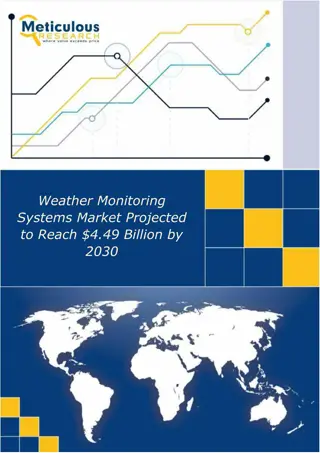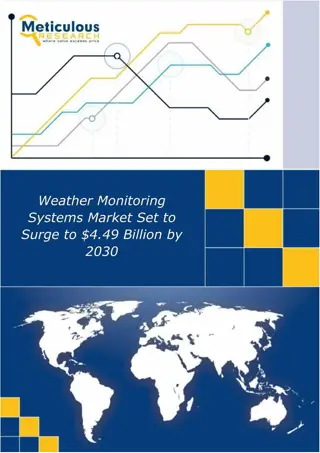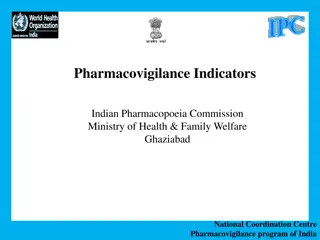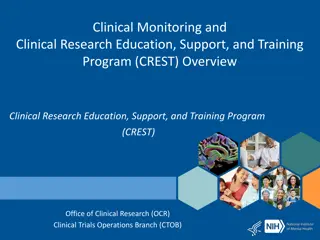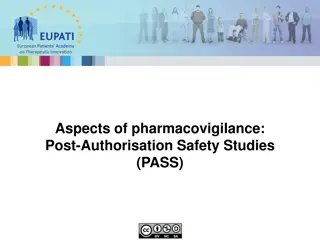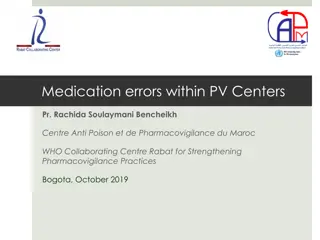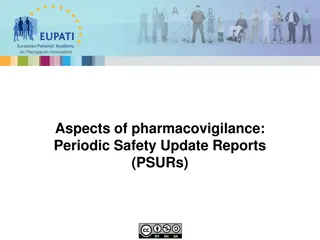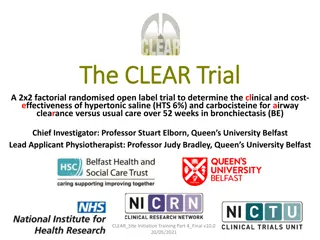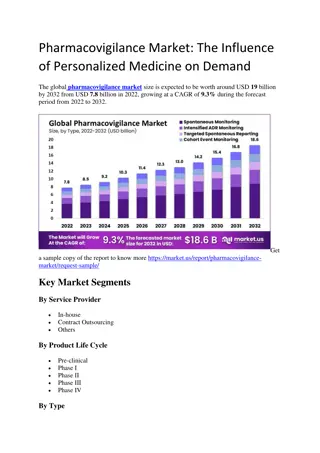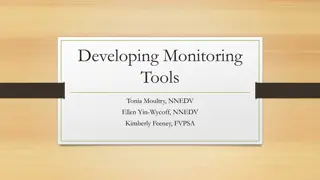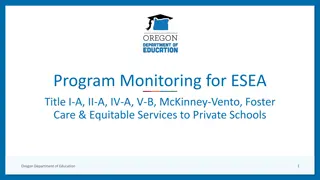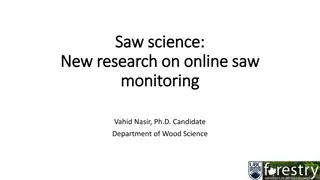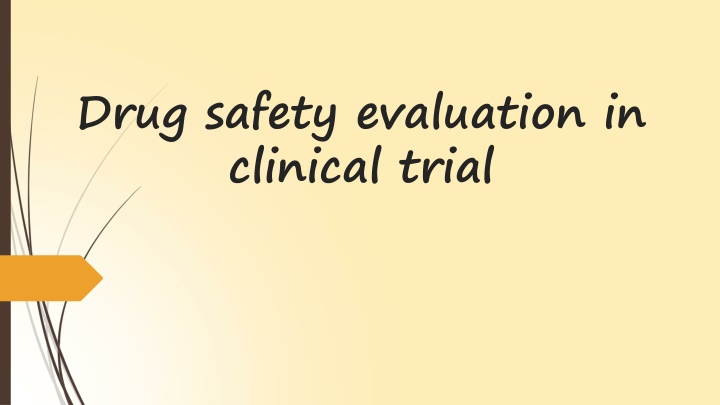
Drug Safety Evaluation in Clinical Trials Overview
Explore the importance of drug safety evaluation in clinical trials, including safety concerns, monitoring, reporting requirements, and postmarketing safety. Learn how pharmacovigilance helps reduce risks associated with medicinal products and the need for international efforts to address drug safety.
Download Presentation

Please find below an Image/Link to download the presentation.
The content on the website is provided AS IS for your information and personal use only. It may not be sold, licensed, or shared on other websites without obtaining consent from the author. If you encounter any issues during the download, it is possible that the publisher has removed the file from their server.
You are allowed to download the files provided on this website for personal or commercial use, subject to the condition that they are used lawfully. All files are the property of their respective owners.
The content on the website is provided AS IS for your information and personal use only. It may not be sold, licensed, or shared on other websites without obtaining consent from the author.
E N D
Presentation Transcript
Drug safety evaluation in clinical trial
Overview 2 Introduction Safety concerns Source of safety information & safety evaluation Safety monitoring IND safety reporting requirements Causality assessment Postmarketing safety & reporting Improving risk assessment & safety Conclusion
INTRODUCTION 3 All medicinal products carry risks in addition to their possible benefits For developing a new medicine, a decision can only be made if both benefits & risks are addressed Risk associated with the drug is minimized when medicines of good quality, safety & efficacy are used rationally by an informed health professional & by patients Pharmacovigilance helps in reducing the risk of harm by ensuring use of good quality medicines appropriately
Introduction 4 Need of international efforts to address drug safety were realized & initiated in 1961, following the Thalidomide disaster Guidelines were developed to monitor drugs, foods & environmental contaminants for adverse reactions & toxicity In beginning, guidelines were restricted to local needs. Globalization - recognized need of a system, accepted internationally, to ensure safety of medicinal products
Introduction 5 New drugs: marketed on basis of comparatively limited information, as clinical trials are designed to answer specific questions In US, ~ 500 to 2000 patients receive a new drug during clinical trials, & only a few hundred of them are treated > 3-6 months In clinical trials, critical efficacy endpoints are identified in advance & sample sizes are estimated for assessment of effectiveness Common AEs are generally identified & well characterized in prospective trials
Introduction 6 Infrequent or delayed AEs: characterized depending on their severity & importance to risk-benefit assessment & require special techniques (e.g., case control studies, cohort studies) Isolated reports: definitive in associating a drug with an AEs, if drug administration & event are temporally related, de-challenge or re- challenge In contrast, with few exceptions, phase 2-3 trials are not designed to test specified hypotheses about safety nor to measure or identify AEs with any pre-specified level of sensitivity Exceptions occur when a particular concern related to drug or drug class has arisen & when there is a specific safety advantage being studied
Introduction 7 Safety evaluation during clinical drug development is not expected to characterize all the AEs, for example, those occurring in < 1 in 1000 patients Risks that may be missed include rare events events occurring after long-term use events occurring in special populations events occurring in association with specific diseases & events occurring in association with concomitant therapy Drug safety evaluation in clinical trial - Dr. Vikas S. Sharma
Safety Concerns 8 Available data depend on the stage of development Safety information on approved products is reflected in product labelling (Package Insert) Up-to-date safety information on the products under investigation is found in Investigator s Brochure (IB) In vitro testing, Nonclinical pharmacology/toxicology studies Clinical safety & pharmacokinetic data, if available For products under investigation, IB is equivalent to Package Insert
Safety Concerns 9 Pharmacology of drug or pharmacologically related drugs can be useful in identification & exploration of major safety concerns E.g., clearance pathway of a drug can be indicative of certain potential drug-drug interactions or certain effects of renal or hepatic function Similarly, pharmacologic class, & prior experience, could lead to focus on particular laboratory or clinical abnormalities E.g., muscle or liver abnormalities: HMGCoA reductase inhibitors, sexual dysfunction: SSRIs & GI, renal & cardiovascular effects: NSAIDs Drug safety evaluation in clinical trial - Dr. Vikas S. Sharma
Safety Concerns 10 Systematic reviews & meta-analyses of clinical trials have recently raised concerns about in risk of serious adverse outcomes (ischemia & arrhythmia): varenicline Mortality: tiotropium inhaler, Similarly, risks of MI: rosiglitazone & CHF & fractures: thiazolidinediones (rosiglitazone & pioglitazone) in clinical trials have resulted in regulatory warnings
Sources of safety information & Safety evaluation Various sources of information are - Spontaneous ADR reporting schemes, Clinical & epidemiological studies, Worldwide published medical literature, Pharmaceutical companies, Worldwide regulatory authorities, Morbidity & mortality databases, Nonclinical data (in vitro, animals), Post marketing experience & Safety profile of other drugs in the same class 11 Drug safety evaluation in clinical trial - Dr. Vikas S. Sharma
Sources of safety information & Safety evaluation 12 Nonclinical information Chemical structure/Drug class Class toxicities In-vitro toxicity evaluation Genotoxicity Cardiac repolarization Pharmacology-Toxicology studies in animals Organ specific toxicities Carcinogenicity Teratogenicity
Sources of safety information & Safety evaluation 13 Information from all of these sources is carefully screened & may identify unexpected SEs; indicate that certain SEs occur more commonly than previously believed, or that some patients are more susceptible to some effects than others Such findings can lead to changes in marketing authorisation of medicine restrictions in use, changes in specified dose of the medicine & introduction of specific warnings of SEs in product information Drug safety evaluation in clinical trial - Dr. Vikas S. Sharma
Sources of safety information & Safety evaluation 14 As new information related to a marketed drug becomes available, regulatory agencies - review the data & evaluates any potential drug safety concern If potential drug safety concern arises, relevant scientific experts within the agency - prompt review & analysis Period of uncertainty - agency evaluates new safety information to determine whether there is an important drug safety issue related to a specific drug or drug class & whether regulatory action is appropriate Drug safety evaluation in clinical trial - Dr. Vikas S. Sharma
Sources of safety information & Safety evaluation 15 During this period, agency - actively engaged in gathering additional safety information Sponsors - evaluate new safety information & provide the results of their analyses to agency during this time As additional data relevant to an emerging drug safety issue become available (e.g., data from an ongoing study or data from available clinical databases) - considered in analysis & decision-making process
Sources of safety information & Safety evaluation 16 Upon evaluation of additional data, further regulatory action - revision to product labelling or - Risk Minimization Action Plan (RiskMAP), as appropriate As agency evaluates a drug safety issue to determine whether regulatory action is warranted - communicate further information to public at appropriate points
Knowing if the subject is fit for the trial 17 As safety of the subject is of utmost importance, it is necessary to determine whether the subject is fit for the trial or not For this, investigation brochure (IB) findings are applied to protocol & a prospective subject Fitness of subject is decided based on Inclusion / Exclusion criteria & by examining the potential for drug accumulation / toxicities Inclusion / Exclusion criteria medical history, lab values & concomitant medications used Examining the potential for drug accumulation / toxicities involves PK parameters, single versus multiple doses & linearity of exposure with dose escalation
Phase 1 / Pharmacokinetic Trials 18 Absorption, metabolism, Cmax, AUC, T1/2 in healthy subjects in patients Drug safety profile in dose escalation trials Healthy volunteers Safety signals supporting nonclinical findings New safety signals in humans only Drug safety evaluation in clinical trial - Dr. Vikas S. Sharma
Ascertainment of Adverse Events 19 By spontaneously reported symptoms or symptoms reported as a result of a probe or both Spontaneously reported symptoms have advantage of detecting more severe episodes, truly unexpected AEs & identifying what s important to the patient But, may lack standardization (e.g. within & across trials) Symptoms reported as a result of a probe (using Checklist & Questionnaire) allows standardization within & across trials But, may miss unexpected AEs
Other Safety Assessments/Monitoring 20 Vital signs Laboratory evaluations CBC LFTs CPK KFTs Pancreatic enzymes Special safety assessments Visual, Hearing Neurological exam ECG
Adverse Event / Experience 22 Any untoward medical occurrence associated with the use of a drug in humans whether or not considered drug related sign, symptom, or disease abnormal lab, imaging, ECG, etc worsening of the above constellation of the above
AE Severity Grading Scales 23 Provide general guidance on parameters for monitoring safety in clinical trials They are specific to: Study population Phase of product development (1-4) Product evaluated (small molecule, therapeutic biologic, device, vaccine) Examples: NCI (National Cancer Institute) DAIDS (Division of AIDS)
Serious Adverse Event 24 An AE or suspected AR is considered serious if, it results in the opinion of the Investigator or Sponsor in any of the following outcomes: death, a life-threatening AE, inpatient hospitalization or prolongation of existing hospitalization, a persistent or significant incapacity or substantial disruption of the ability to conduct normal life functions, or a congenital anomaly/birth defect, or requires intervention to prevent permanent impairment or damage
Unexpected Adverse Event 25 Not listed in the Investigator s Brochure (IB) or if IB not available or required Not listed at the specificity or severity observed Mentioned in IB as anticipated due to pharmacokinetic properties of the drug or occurred with other drugs in this class, but not with the study drug Not consistent with the risk information described in the general investigational plan or elsewhere in current application, as amended
Other definitions 26 Adverse drug reaction: AE that has a causal relationship with the medicinal product Suspected adverse reaction: Any AE for which there is a reasonable possibility that the drug caused the adverse event Life-threatening adverse reaction: An AE or suspected AR is considered life-threatening if, in the view of either the investigator or sponsor, its occurrence places the patient or subject at immediate risk of death
Other definitions Suspected serious Adverse Reaction (SSAR): Adverse reaction that is classed in nature as serious & is consistent with information about medicinal product in question 27 Suspected unexpected serious Adverse Reaction (SUSAR): Adverse reaction that is classed in nature as serious & is not consistent with information about medicinal product in question In case of a licensed product, in summary of product characteristics for that product In case of any other investigational medicinal product, in the investigator s Brochure (IB) relating to trial in question Drug safety evaluation in clinical trial - Dr. Vikas S. Sharma
Investigational New Drug (IND) Safety Reporting Requirements 28 Unexpected fatal or life-threatening suspected AEs - important safety information & thus, must be reported more rapidly to FDA Any unexpected fatal or life-threatening suspected AR reported in no later than 7 calendar days after the sponsor s initial receipt of the information If the safety report submitted within 7 calendar days is complete, additional submission within 15 days from day zero is not required
Investigational New Drug (IND) Safety Reporting Requirements Sponsor must also report any findings from clinical, epidemiological, or pooled analysis of multiple studies or any findings from animal or in vitro testing: significant risk in humans exposed to drug (e.g., mutagenicity, teratogenicity, carcinogenicity) 29 Follow-up IND Safety Report If sponsor obtains any relevant additional information submitted no later than 15 calendar days after the sponsor receives the information Drug safety evaluation in clinical trial - Dr. Vikas S. Sharma
Investigational New Drug (IND) Safety Reporting Requirements 30 IND annual safety report - required of all IND holders & should include most frequent & most serious AEs by body system, list of subjects who died, including cause & list of subjects who dropped out in association with an AE
Expedited Safety Reporting to FDA by Sponsor 31 Adverse Events that meet all three criteria are reported to FDA (SUSAR): Serious (S) Unexpected (U) Suspected Adverse Reactions (SAR) Fatal or life-threatening SUSAR should be reported to FDA no later than 7 days Others SUSAR should be reported to FDA no later than 15 days
Causality assessment 32 An inherent problem in pharmacovigilance: most case reports concern suspected ADRs Adverse reactions are rarely specific for the drug, diagnostic tests are usually absent & re-challenge is rarely ethically justified In practice, few adverse reactions are certain or unlikely; most are somewhere in between possible & probable
Causality assessment 33 Statistical analysis can lead to structured & harmonized assessment of causality by decreasing disagreement between assessors, classifying relationship likelihood, marking individual case reports & improvement of scientific evaluation It can be particularly useful for evaluation of common AEs Causality assessment can be performed simply by categorizing evidence by the quality of its sources & evaluating evidence of a causal relationship using standard guidelines
Causality assessment Various sources for causality assessment can be clinical trials, cohort or case-control studies, time-series studies & case-series 34 Individual assessment unlikely to help determine attribution for common AEs, i.e. headache, nausea, MI in elderly Such AEs require aggregate analyses using a population approach (risk or rate with study drug vs. control) Placebo or active control Other doses in multiple dose studies
Causality assessment 35 Use of standard guidelines for evaluating the evidence of a causal relationship may include temporal relationship, strength of association, dose-response relationship, consideration of alternate explanations, cessation of exposure, specificity of the association & consistency with other knowledge
FDA system of managing risks 36 FDA approves a product: benefits of using a product outweigh the risks for the intended population & use Major goal of premarketing review: ensure that products are truthfully & adequately labelled for the population & use Labelling is given considerable emphasis: chief tool the Agency uses to communicate risk & benefit to the healthcare community & patients Once medical products are in the market - ensuring safety is principally the responsibility of healthcare providers & patients, who make risk decisions on an individual basis Drug safety evaluation in clinical trial - Dr. Vikas S. Sharma
FDA system of managing risks 37 They are expected to use the labelling information to select & use products wisely, thereby minimizing AEs To assist with post marketing risk management, Agency maintains a system of complex post marketing surveillance & risk assessment programs To identify AEs that are not identified during development & premarketing review Agency uses this information to initiate labelling updates &, on rare occasions, to re-evaluate the marketing decision Drug safety evaluation in clinical trial - Dr. Vikas S. Sharma
Postmarketing Safety 38 Postmarketing surveillance (PMS): practice of monitoring the safety of a pharmaceutical drug or medical device after it has been released in the market Since drugs are approved on the basis of clinical trials, which involve relatively small numbers of people who normally do not have other medical conditions which may exist in the general population Thus, PMS can further refine, or confirm or deny, the safety of a drug after it is used in the general population, who have a wide variety of medical conditions
Postmarketing Safety 39 Approaches to monitor the safety of licensed drugs: Spontaneous reporting databases, Prescription event monitoring, Electronic health records, Patient registries, Nonclinical studies, Observational studies and Record linkage between health databases These data are reviewed to highlight potential safety concerns in a process known as data mining Drug safety evaluation in clinical trial - Dr. Vikas S. Sharma
Postmarketing Safety 40 For post-market safety evaluations, data sources are Product's preapproval safety profile, Current FDA-approved label, Reports made to FDA Adverse Event Reporting System (FAERS), Reports made to Vaccine Adverse Event Reporting System (VAERS), Manufacturer submitted periodic safety update reports (PSURs), Medical literature, Drug utilization databases & Data from post-approval clinical trials & other studies, when applicable
Postmarketing Reports 41 For ensuring drug safety on long term & on a wider population, regulatory authorities ask the marketing authorization holders (MAH) for Reporting of AEs & Periodic submission of safety reports For serious & unexpected AEs, FDA recommends reports to be submitted within 15 calendar days either foreign or domestic Follow up to 15-day alert reports should be submitted within 15 calendar days
Post Marketing Surveillance under Schedule Y 42 Applicant shall furnish PSURs in order to- a) report all relevant new information from appropriate sources; b) relate the data to patient exposure; c) summarise market authorisation status in different countries & any significant variations related to safety; & d) Indicate whether changes shall be made to product information in order to optimize the use of product Ordinarily all dosage forms & formulations as well as indications for new drugs should be covered in one PSUR
Post Marketing Surveillance under Schedule Y 43 The applicant shall submit PSUR every six months for the first two years. For subsequent two years, the PSUR shall be submitted annually. PSURs due for a period must be submitted within 30 calendar days of the last day of the reporting period If marketing of new drug is delayed by applicant after obtaining approval to market - such data will have to be provided on deferred basis beginning from the time new drug is marketed
Post Marketing Surveillance under Schedule Y 44 Data emerging through PSUR or other PMS studies basis of further decision about indication / usage / restriction on indication of pharmaceutical product & further decision on extension of duration of submission of PSUR data beyond 4 years may be taken All cases involving serious unexpected ARs must be reported to the licensing authority within 15 days of initial receipt of the information by the applicant
Reporting of SAEs Drug safety evaluation in clinical trial - Dr. Vikas S. Sharma
New safety data related to combination therapy 47 If PSUR is for fixed combination product summarise important safety information arising from individual component Information specific to combination can be incorporated into separate section(s) of PSUR for one or all of the individual components of the combination
Literature monitoring MAHs shall perform monthly literature search of their product by using electronic literature database 48 Any AEs / ADRs identified by this process needs to be processed as per spontaneous Individual Case Safety Report (ICSR) Follow-up ICSR Any missed information in the form of supplementary detailed information required for clinical evaluation of ICSR reported to NCC-PvPI, IPC When all the essential elements are reported in an individual report ICSR (Identifiable reporter, identifiable patient, suspected pharmaceutical product & AE/ADR) Drug safety evaluation in clinical trial - Dr. Vikas S. Sharma
Literature monitoring 49 All serious unexpected AEs, reported to licensing authority within 15 calendar days of initial receipt of information by the applicant All serious AEs/ADRs, reported to regulatory authority / NCC-PvPI, IPC within 15 calendar days of initial receipt of information by the MAHs All non-serious AEs/ADRs, reported to NCC-PvPI, IPC within 30 calendar days of initial receipt of information by the MAHs
Adverse events following immunisation (AEFI) 50 Licensing authority - advise MAH to conduct Phase IV trial in case of demonstration of product safety, efficacy & dose definitions AEFI can be serious or non serious. Serious AEFIs - reported immediately & investigated timely Non-serious AEIFs - reported routinely in health management information system (HMIS) Based on causality assessment report, detailed inspection related to GMP, product etc. & further regulatory action are initiated by CDSCO in case quality of implicated vaccines are responsible for AEs

